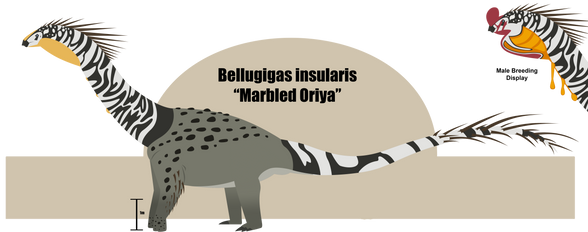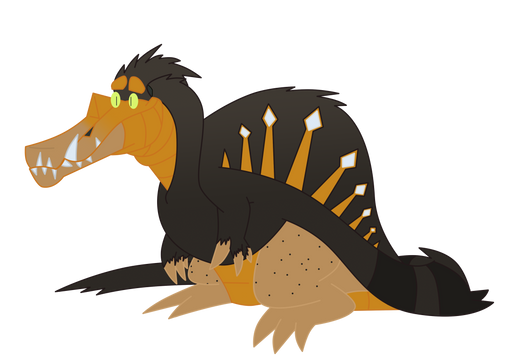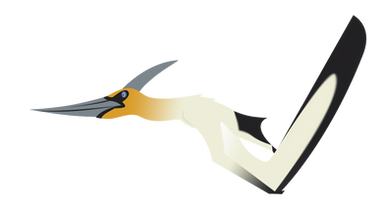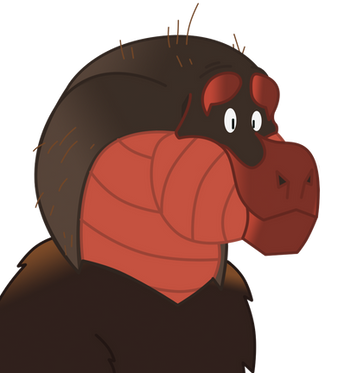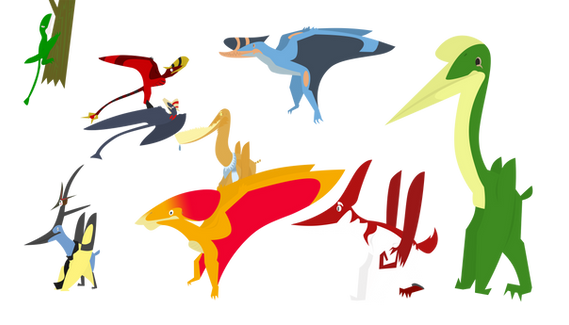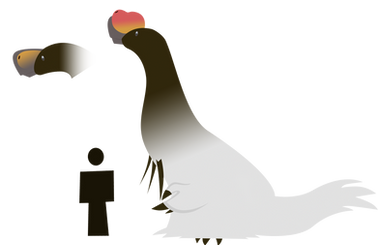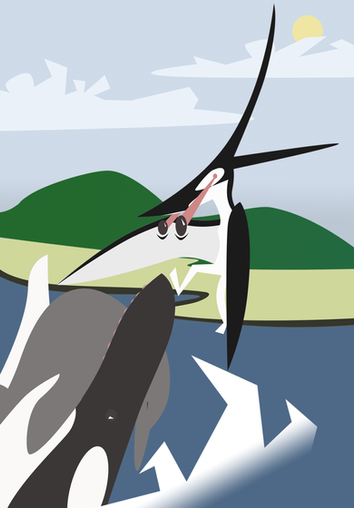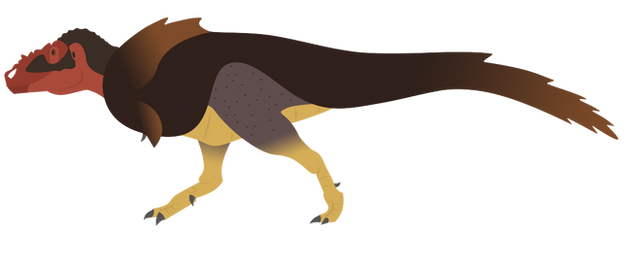HOME | DD
 Krookodile0553 — Tyrants of Araea
Krookodile0553 — Tyrants of Araea

Published: 2013-06-12 21:25:15 +0000 UTC; Views: 2735; Favourites: 26; Downloads: 7
Redirect to original
Description
"Organized from largest to smallest...""It was around six in the morning and I was laying half awake in my tent, listening to the soft pattering of rain drops on the canvas and to the dawn chorus of insects, birds and tree frogs in the forest around me. I had pitched my tent in a small clearing the night before following a long day's climb through the heavily forested hills. I had slept deeply but I would have to pack up camp soon. I needed to get an early start if I wanted to reach the plateau by nightfall but for now I was enjoying this limbo between wakefulness and sleep. For a long time I lay with my eyes shut simply taking in the sounds. The almost imperceptible snapping of a twig suddenly jolted me to full alertness even before my conscious mind was truly aware of the sound. Outside of the tent I could now sense a presence, as it approached closer I could discern heavy but quiet footfalls and the steady breaths of something large. Clumsily I fumbled for the big .452 revolver, a gift my father had insisted I take with me that until this moment had ridden largely forgotten in my pack during this trek. Retrieving the weapon I clutched it tightly, knowing that it now probably represented the difference between life and death for me. Only a thin sheet of rubberized canvas separated me from the mysterious visitor outside. Whatever its identity, it was snuffling loudly now, moving around toward the entrance flap, clearly following my scent. Panic gripped me now and I raised the revolver to eye level, pointing it toward the flap which now pushed inward. A large toothy snout came into view, indicating a dietary predilection of the carnivorous persuasion, and behind that a pair of almost luminous light blue eyes. I probably should have shot then, but I didn't. It became an odd sort of stalemate. We simply stared at each other for some time, engaging in a contest of nerves. I sensed that neither of us had encountered the other's kind before and that we were each waiting for the other to make the first move. Nobody did. Finally I broke the long silence ..'Well one of us better damn well do something..' I said abruptly. At that, my camp visitor blinked one long slow deliberate blink and then was gone, somehow giving the impression that its departure was more the product of boredom then fear. In a flash I was out of the tent, revolver still at the ready I wheeled in a fast circle to to try and locate the creature. It was nowhere to be seen, and no footprints or crashing brush to betray the direction in which it had gone, it had just melted away. There was only the rising sun, emerging over the eastern peak, piercing the previous night's rainclouds with its rays, and the forest sounds to which I had grown so accustomed. It was as if the entire strange encounter had been nothing more then a dream."
-------Marlena Villanova, a notable explorer, recounts an meeting with a Cloud Tyrant a five years before the species' formal recognition by science.
The cloud tyrant (Cryptotyrannus nebulosus) is named for it's blotched grey coat of feathers and for it's preferred habitat, the temperate montane cloud forests in the north of Araea.
It it something of a Therizinosaur killing specialist, with Chironyx silvestris - the Forest Sabredrak, being favored prey. The Cloud Tyrant hunts by moving slowly and quietly through the forest, often tracking its prey by hearing and smell due to the poor visibility sometimes encountered in the dense undergrowth. It will stalk as close as possible before bursting from cover to deliver a lethal bite. When attacking Therizinosaurs the necks are often targeted and a cloud tyrant is capable of beheading a sabredrak with one bite before the creature can repel the attack with its huge hand claws. In addition to Sabredraks, other common prey items include serrat and mountain ornets. Small prey is hunted incidentally as well.
They are a largely solitary species, outside of the mating season, the only social organization exhibited by the species is that of a female with chicks. Despite the protection of their mother young cloud tyrants suffer high mortality due to predators and parasites, which are common in the moist forests. Unrelated adult males will engage in cannibalism if the opportunity presents itself and the Agilisuchian crocodiles won't hesitate to snatch a youngster from under its mother's nose.
Most Araean zoologists place it in the same genus as the more common dune tyrant, although there are many physical differences between the two species and some propose that the species deserves it's own genus. However in captivity the two species have been known to hybridize and produce fertile offspring, which suggests the two are closely related enough that separation at the genus level is not warranted. The Cloud Tyrant was one of the most recently discovered species of large fauna on the island. It's isolated habitat and secretive ways helped mask it's existence for nearly two decades after the formal survey of Araea's native fauna had begun.
-------------------------------------------------------------------------------------------------------------------------------------------------
The Dune Tyrant (Cryptotyrannus reticulatus), is also called the "Nachtrauber" by the Germanic settlers in the island's interior. It is a 500-800 pound (females average slightly larger then males) cursorial Tyrannosaurid with almost ornithomimid-like limb morphology. As the name implies they are most common in arid desert terrain and dry woodlands, particularly in Araea's interior and southern regions, but of late it's range extends into the more forested northern part of the island as well. They are surprisingly adaptable and in the wake of human settlement have become frequent killers of livestock and periodic man eaters as well. (i think of their post-colonization niche as that of a quarter ton coyote that also sometimes dines on the ranchers as well) for a large animal they reproduce extremely quickly. One of the few dinosaur species to actually EXPAND it's range since human colonization. The basic social unit is the mated pair who aggressively defend a territory, they are often accompanied by a brood of young. Dune Tyrants vocalize little but at dawn and dusk adult dune tyrants will sometimes engage in territorial calling, emitting a deep guttural "sawing" vocalization for several minutes at a time. Pairs may engage in this together or if they are separated one may initiate the calling, and will be answered by it's mate some distance away. Only adults in possession of a permanent territory are known to vocalize in this manner. The unmistakable calls are one of the most distinctive sounds in the wilds of Araea.
Natural prey include most ornithiscian species (particularly the smaller Leptolophine Ornets) as well as young Oriya and ornithomimids. Prey is usually stalked from cover then captured in a swift rush. Prey is often dispatched with a crunching bite to the head or neck, smaller prey is often seized and shaken violently. Big prey is often first disabled with a bite to the flank or caudiofemoralis muscle then allowed to bleed out before being killed with a neck bite. Cooperative hunting of large prey may occur among mated pairs however more commonly mated individuals hunt independently within their territory.
Measurements of the bite forces of captive dune tyrants have yielded figures of up to 3500 pounds, and it is speculated by some that they are capable of biting even harder then that.
Dune tyrants lay large clutches of up to fifteen eggs in nests constructed of rotting vegetation and the young emerge from the egg very small, but they are long limbed and quite mobile and within a few weeks of hatching are able to follow their parent's wanderings, often hunting insects and small vertebrates for themselves as they loosely follow their parents. Adults feed and protect their young at hatching though progressively less such care is provided as the young age until the point they are often driven from the territory to make room for a new brood. This usually occurs when the young are about 1/2 grown. At this point the young Tyrants form large unruly packs that exist on the fringes of adult territories. Under natural circumstances many of these young would starve or be killed by territorial adults but the presence of domestic livestock in much of the Dune Tyrants' range creates a situation where more young survive to adulthood due to more easily available food, the same overabundance of food often leads adult pairs to become lazy and more tolerant of the presence of juveniles in their territory as well.
Dune Tyrants are often believed to be mostly nocturnal due to the fact that their depredations on livestock typically occur at night. However research suggests that nocturnal activity is a learned behavior to avoid human persecution, rather then an evolved adaptation. Dune Tyrants studied in areas away from human habitation were found to be primarily diurnal or crepuscular. Studies also indicate that their eyes have relatively few specialized nocturnal adaptations and in experiments both captive and wild individuals seem to exhibit a full range of color vision. Like most theropods, a Dune Tyrant probably sees no better in the dark then an average human, and they seem to use olfaction extensively in navigating at night.
The largest example of this species on record is an adult female shot in Kundapur province, the specimen measured 16 feet 2 inches and weighed 878 pounds.
A melanistic (black) color morph is sometimes found in the northern, less arid part of their range. Black male dune tyrants typically have lower breeding success then normally colored counterparts as their excess pigmentation inhibits the development of the bright facial colors males display during the breeding season. The Black Queen of Tunari was a particularly well known melanistic dune tyrant. a prolific man-eater, she terrorized the settlement of Tunari and the surrounding areas for nearly five years, attacking at night and always managing to elude pursuing hunters in the heavily forested hills. By the time she was finally shot by noted professional hunter Reginald Tilson the Black Queen was reputed to have killed and eaten over 130 people. At the time of her death she was estimated to be around ten years old and weighed 624 pounds, was just under 14 feet long, and aside being blind in her left eye, was reportedly in excellent physical condition. Tilson devoted a chapter in his autobiography to an account of this incident entitled "The Queen Must Die: The Hunt for the Maneater of Tunari"
------------------------------------------------------------------------------------------------------------------------------------------------------
Cursotyrants (Cursotyrannus elegans) are diurnal hunters that specialize in fast prey. Typically they hunt in pairs, sometimes running in relays to wear their victims out. Ornithomimids, tik-tiks, savannah darters, small ornets are taken. The most common tactic with prey such as ornithmimids is to come up astern of them during pursuit and aim a slashing bite at the thigh or caudofemoralis muscle to disable the prey, at which point it is finished off with a bite to the head or neck. Cursotyrant teeth are more bladelike then those of their larger relatives allowing them to land precise slashing bites on their quarry's locomotor musculature. Kleptoparisitism of Cursotyrannus kills by other their larger cousin the dune tyrant, and by packs of vorgas is widespread. Even groups of skrykes are known to force the gracile tyrants off their kills on occasion.
The breeding strategy is similar to that of the larger Dune Tyrant, they are fast breeding R strategists who lay large clutches of eggs which hatch into young with high mortality rates. Parental care is limited. Young are fed shortly after hatching but as they become more agile with age they forage for themselves. The parents become increasingly less protective of their brood as they mature until they are eventually driven out of the territory. Unlike juvenile dune tyrants the vagrant youngsters do not form large "packs", instead they disperse, most likely to avoid the attention of predators.
Also like the Dune Tyrant, they will take livestock but they are less tolerant of proximity to humans and are much rarer around settled areas then their larger relative. Though there have been documented cases of Cursotyrannus killing (and eating) humans they are not known to become habitual maneaters like their bigger cousins.
In Kundapur province Cursotyrannus is commonly bred in captivity and kept by wealthy landowners and used in competitive coursing events and recreational hunting (Including massive canned hunt events in large fenced in outdoor "arenas"). Captive individuals are known to be surprisingly tame, though still not totally trustworthy, as a result most of their human contact comes via designated experienced "handlers" appointed to the task by the owners. The actual owners typically have very little genuine interaction with their captive cursotyrants. Specimens from top bloodlines and individuals with interesting color variations can fetch top dollar. The tyrant's "exotic" aspect is the primary attraction for the wealthy upper class.
Most subsistence hunters who pursue both native and introduced wild game for the table agree that a good dog is a far more versatile and obedient (and safer) hunting companion.
Related content
Comments: 9

Really nicely done! But for some reason, I was under the impression that the Cloud Tyrant was smaller than the Dune Tyrant. Not sure why.
👍: 0 ⏩: 1

It is; the Dune Tyrant's just sitting on the ground...
👍: 0 ⏩: 1

Sorry, by smaller I meant by mass, not height. In this image, the Cloud Tyrant looks as if it is twice the mass of a Dune Tyrant and at least 20 feet long.
👍: 0 ⏩: 1

Oh that, yes I did make Cloud's more bulky than Dune's... I honestly forgot to make this individual Dune larger but overall the two "Megatyrants" weigh the same "with the exception of Dune's being taller", also I made Dunes less conservative morphologically than before, emphasizing the Ornithomimid characteristics (long legs/Shorter tail) that they have...
👍: 0 ⏩: 0

I didn't realize you had put these up. Nice work.
👍: 0 ⏩: 1

How long has it been since you first posted the Cloud Tyrant?... XD
👍: 0 ⏩: 1

Over two years. It is still due for an overhaul.
👍: 0 ⏩: 1

I don't know why, but I didn't like how I did the Oscillations on the Cloud and Dune's "plumage"... Oh well, fur texture on vector art's a pain in the tail...
👍: 0 ⏩: 0

I love the colors and the design... Hope you do the Marbled Oriya and the Sabredraks
👍: 0 ⏩: 0
